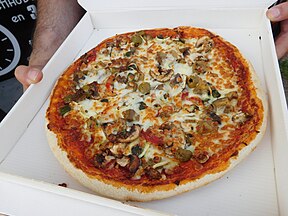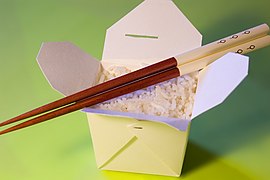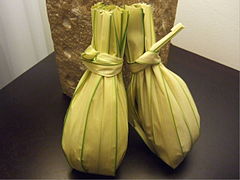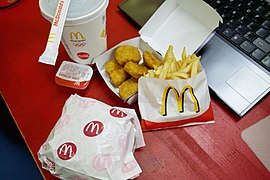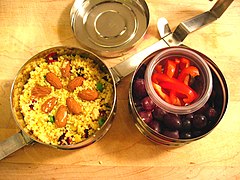
Fast food is a type of mass-produced food designed for commercial resale, with a strong priority placed on speed of service. It is a commercial term, limited to food sold in a restaurant or store with frozen, preheated or precooked ingredients and served in packaging for take-out/takeaway. Fast food was created as a commercial strategy to accommodate large numbers of busy commuters, travelers and wage workers. In 2018, the fast food industry was worth an estimated $570 billion globally.
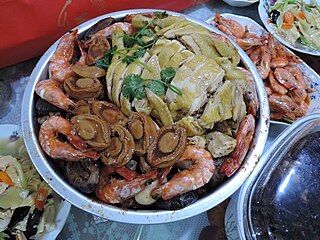
Poon choi or puhn choi, pén cài in pinyin, is a traditional Cantonese festival meal composed of many layers of different ingredients. It is served in large wooden, porcelain or metal basins called poon, due to the communal style of consumption. The Chinese name, transliterated as Poon choi, has been variously translated as "big bowl feast", "basin cuisine" or "Chinese casserole".

The throw-away society is a generalised description of human social concept strongly influenced by consumerism, whereby the society tends to use items once only, from disposable packaging, and consumer products are not designed for reuse or lifetime use. The term describes a critical view of overconsumption and excessive production of short-lived or disposable items over durable goods that can be repaired, but at its origins, it was viewed as a positive attribute.

A disposable is a product designed for a single use after which it is recycled or is disposed as solid waste. The term is also sometimes used for products that may last several months to distinguish from similar products that last indefinitely. The word "disposables" is not to be confused with the word "consumables", which is widely used in the mechanical world. For example, welders consider welding rods, tips, nozzles, gas, etc. to be "consumables", as they last only a certain amount of time before needing to be replaced. Consumables are needed for a process to take place, such as inks for printing and welding rods for welding, while disposable products are items that can be discarded after they become damaged or are no longer useful.

Leftovers are surplus foods remaining unconsumed at the end of a meal, which may be put in containers with the intention of eating later. Inedible remains like bones are considered waste, not leftovers. Depending on the situation, the amount of food, and the type of food, leftovers may be saved or thrown away.

An oyster pail is a folded, waxed or plastic coated, paperboard container originally designed to hold oysters. It commonly comes with a handle made of solid wire. It is often used by American Chinese cuisine restaurants in the United States to package take-out food. It can also be found in other Western countries, such as Australia, New Zealand, Germany, Poland, England and Brazil, but is rarely seen in China and other Asian countries with high numbers of ethnic Chinese.

Online food ordering is the process of ordering food, for delivery or pickup, from a website or other application. The product can be either ready-to-eat food or food that has not been specially prepared for direct consumption.

A food court is generally an indoor plaza or common area within a facility that is contiguous with the counters of multiple food vendors and provides a common area for self-serve dinner. It can also be a public dining area in front of a cafe or diner.
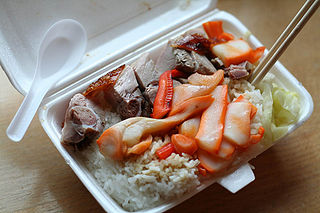
A foam food container is a form of disposable food packaging for various foods and beverages, such as processed instant noodles, raw meat from supermarkets, ice cream from ice cream parlors, cooked food from delicatessens or food stalls, or beverages like "coffee to go". They are also commonly used to serve takeout food from restaurants, and are also available by request for diners who wish to take home the remainder of their meal. The foam is a good thermal insulator, making the container easy to carry as well as keeping the food at the temperature it had when filled into the container, whether hot or cold.

Disposable food packaging comprises disposable products often found in fast-food restaurants, take-out restaurants and catering establishments. Typical products are foam food containers, plates, bowls, cups, utensils, doilies and tray papers. These products can be made from a number of materials including plastics, paper, bioresins, wood and bamboo.

Customs and etiquette in Chinese dining are the traditional behaviors observed while eating in Greater China. Traditional Han customs have spread throughout East Asia to varying degrees, with some regions sharing a few aspects of formal dining, which has ranged from guest seating to paying the bill.

Western-style fast food in mainland China is a fairly recent phenomenon, with Kentucky Fried Chicken (KFC) establishing its first Beijing restaurant in November 1987. This location was met with unprecedented success, and served as a model for many local Chinese restaurants that followed it.

Food delivery is a courier service in which a restaurant, store, or independent food-delivery company delivers food to a customer. An order is typically made either by telephone, through the supplier's website or mobile app, or through a third party food ordering service. The delivered items can include entrees, sides, drinks, desserts, or grocery items and are typically delivered in boxes or bags. The delivery person will normally drive a car, but in bigger cities where homes and restaurants are closer together, they may use bikes or motorized scooters.

A disposable cup is a type of tableware and disposable food packaging. Disposable cup types include paper cups, plastic cups and foam cups. Expanded polystyrene is used to manufacture foam cups, and polypropylene is used to manufacture plastic cups.

Zume, Inc. was an American manufacturing-technology company headquartered in Camarillo, California. Founded in 2015 as an automated pizza parlor, in 2020 the company shifted to food packaging and delivery logistics. In June 2023, the company was shut down.
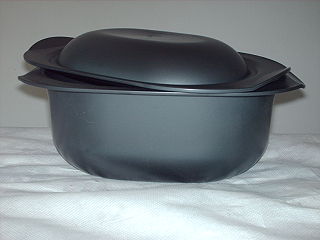
Plastic containers are containers made exclusively or partially of plastic. Plastic containers are ubiquitous either as single-use or reuseable/durable plastic cups, plastic bottles, plastic bags, foam food containers, Tupperware, plastic tubes, clamshells, cosmetic containers, up to intermediate bulk containers and various types of containers made of corrugated plastic. The entire packaging industry heavily depends on plastic containers or containers with some plastic content, besides paperboard and other materials. Food storage nowadays relies mainly on plastic food storage containers.

Disposable tableware includes all disposable tableware like

Packaging waste, the part of the waste that consists of packaging and packaging material, is a major part of the total global waste, and the major part of the packaging waste consists of single-use plastic food packaging, a hallmark of throwaway culture. Notable examples for which the need for regulation was recognized early, are "containers of liquids for human consumption", i.e. plastic bottles and the like. In Europe, the Germans top the list of packaging waste producers with more than 220 kilos of packaging per capita.

The COVID-19 pandemic impacted the United States restaurant industry via government closures, resulting in layoffs of workers and loss of income for restaurants and owners and threatening the survival of independent restaurants as a category. Within a week after the first closures, industry groups representing independent restaurateurs were asking for immediate relief measures from local, state, and federal governments, saying that as many as 75 percent of independent restaurants could not survive closures of more than a few weeks. By late July, nearly 16,000 restaurants had permanently closed.

In the late 20th and early 21st century, there has been a global movement towards the phase-out of polystyrene foam as a single use plastic (SUP). Early bans of polystyrene foam intended to eliminate ozone-depleting chlorofluorocarbons (CFCs), formerly a major component.


